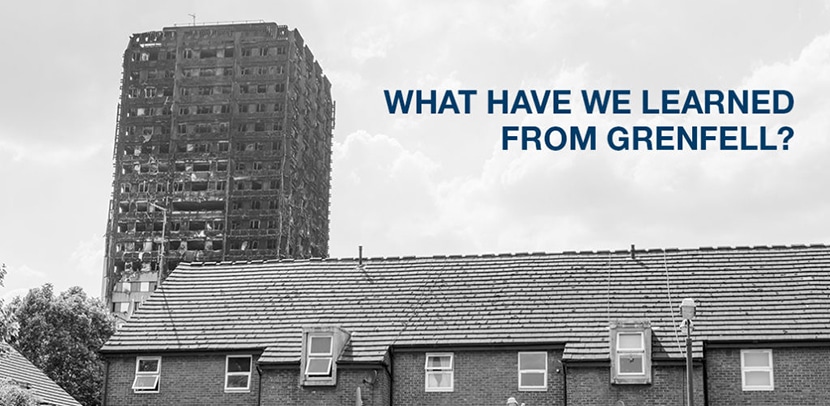What have we learned from Grenfell?
Feb 16, 2018

What has the construction industry learned from the Grenfell Tower disaster?
The Grenfell Tower fire was one of the worst incidents of its kind to occur in the UK. And, as a result, it’s made the UK reexamine attitudes toward fire safety. It has raised concerns over current building regulations and processes, which need to be reviewed and changed to prevent a similar incident happening in the future.
What happened?
Grenfell Tower was a 24-storey concrete tower block in North Kensington, London. A refurbishment, completed in 2016 saw new windows, cladding and insulation added to the block.
On Wednesday 14 June 2017, Grenfell Tower caught fire. The tragedy resulted in 71 deaths and 70 injuries. 223 people escaped the blaze.
The aftermath
The Government launched an inquiry into the event to understand how the fire spread so quickly through the tower.
The results found that it was likely that the exterior cladding and insulation may have provided optimum conditions for the fire’s growth.
Approximately 18 tonnes of insulation foam and 8 tonnes of cladding were used in the refurbishment. The insulation chosen was only acceptable if used with non-combustible cladding.
However, it was revealed that the cladding that contractors used during the renovation was not fire-resistant; it was 14 times the combustibility limit (BBC). The cladding used was cheaper, and as it turned out, more flammable.
The fire, caused by a faulty fridge-freezer, was exacerbated due to the combination of flammable insulation and cladding that had been installed during renovation works on the building. A 50mm cavity between the insulation and cladding created a chimney-effect that helped to spread the flames.
Following the incident, there came concerns over other buildings in the UK. The government responded by announcing plans to test 600 buildings, which revealed that 262 towers in the UK had a failed cladding system (The Guardian).
Repair works across the country
Following the Government’s tests of cladding systems on other buildings, they declared that urgent repairs be made to unsafe buildings
“There are a large number of high-rise residential buildings, in the public and private sectors, as well as other buildings such as schools and hospitals, where the existing cladding is likely to need to be removed and replaced to ensure the building is safe.” – Civil Servant, The Guardian
While repair works have commenced, it will take time. Local authorities across the country have agreed to pay for emergency works to replace cladding on affected buildings, but the issue still affects private buildings.
Building regulations scrutinised
While the focus has weighed heavily on the building’s renovations, the incident has raised fresh concerns over regulation in the UK that laid the groundwork for this situation to occur.
For example, in the UK there are no regulations requiring the use of fire-retardant material in cladding used on the exterior of tower blocks and schools (The Guardian).
A more robust regulatory system is needed, and, it’s because of this, that the Government launched an Independent Review of Building Regulations and Fire Safety.
“We must learn the lessons of the Grenfell Tower tragedy and ensure that a fire like this cannot happen again. Following the fire, I commissioned a series of large-scale tests, which have raised the question of whether there have been potential systemic failures within the building regulatory and fire safety system.” – Sajid Javid, Secretary of State for Housing, Communities and Local Government (www.gov.uk)
Dame Judith Hackitt, who heads up the review, has said in her interim report that the current building regulations are “unfit for purpose,” and the culture of “doing things as cheaply as possible” has to end (The Guardian).
The final report is due in Spring 2018.
Unfortunately it has taken a disaster like Grenfell to shock the government and the industry to think more about building regulations and fire safety.
The review will have an impact on the construction industry and will influence best practice, quality control and types of material that can be used in projects.
Ideally, the independent review will help to improve regulations and make them more straightforward. This will ensure that everyone involved in building works, from the contractors to the inspectors, are without doubt on what they can and cannot implement.
There are a great many contributing factors that resulted in the Grenfell Tower disaster. Nevertheless, while the refurbishment at Grenfell was under immense pressure to lower costs, you cannot put a price on safety.
In the meantime, inspectors, architects and contractors will likely have Grenfell in the back of their mind for large-scale projects.
There are many fire-resistant products out there to use within your fire systems. For example, Flamstop has a range of wall barriers and stop socks to use within wall cavities that help to delay the spread of fire.



